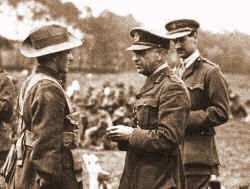Near June 1916, he arrived in France as major general, leading the new 3rd
division. He intensively trained his men. There he used raiding tactics badly considered
by British High Command. Nevertheless, he impressed by his sense of detail, his precision
in a war difficult to lead. During the third battle of Yper, his reputation and
Australians’ one increased under general Plumer command (2nd British Army). He always
trained his troops to reach the highest efficiency degree.
He had understood how to coordinate the use of infantry, air power, and artillery
and tanks. In June 1918, he succeeded general Birdwood as Australian Corps commander. At
the battle of Hamel, on 4 July 1918, his tactics allowed a victory very useful for the
Allied. On 12 August 1918, king Georges V made Monash knight on the field in Bertangles.
Then the Australians advanced in France. Diggers were used as shock troops in a series of
amazing victories: August 1918 offensive, Chuignes, Mont-Saint-Quentin, Péronne,
Hargicourt and finally the Hindenburg line.
For many observers, none of the generals at this war compared with him in
charisma, management, ingenuity or intellect. He won the respect and loyalty of diggers.
Even if British senior officers often reminded him that he was only a simple Jewish
colonel. Sir John Monash, certainly one of the founders of modern Australia, died on 8
October 1931. He had state funeral attended by nearly 300,000 people.


